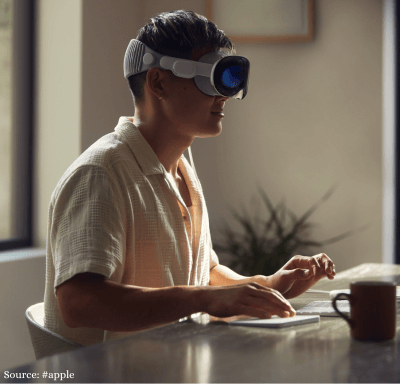
About us
Our Services
Our Expertise
Our Experience
Follow us
Why e2logy?
- We strive to provide superior customer service and ensure that every client is completely satisfied with our work.
- Our engineers are trustworthy, dedicated, and experienced and will go the extra mile to solve your IT issues.
- We are committed to delivering outstanding, cutting-edge IT solutions that add real value that goes beyond what is expected.

Apple Vision Pro Headset: Immersive Reality Redefined

Apple’s Worldwide Developers Conference commenced on Monday, initiating with a keynote presentation that showcased the upcoming additions to the company’s range of devices. However, this year marked a departure as Apple also unveiled new hardware during the event.
As Tim Cook explained in the presentation, the Apple Vision Pro was a “new kind of computer”. Apple characterizes it as “a revolutionary spatial computer that seamlessly blends digital content with the physical world, while allowing users to stay present and connected to others.” By introducing Vision Pro, Apple seeks to cement its dominance in the realm of augmented reality (AR), providing developers and users with a robust hardware and software ecosystem that empowers both parties.
Hardware
The Vision Pro showcases an exceptional display system, boasting an ultra-high resolution with a total of 23 million pixels spread across two micro-OLED displays. This impressive pixel density surpasses that of a 4K television, delivering an immersive visual experience with unparalleled clarity and detail for each eye.
At its core, the Vision Pro functions as a powerful computer, housing Apple’s cutting-edge M2 chip typically found in their highest-end computing devices. However, the headset’s performance is further enhanced by the presence of the new R1 chip, responsible for efficiently processing inputs from the 12 cameras, five sensors, and six microphones.
By swiftly transmitting this data to the M2 chip, lag is minimized, ensuring that new images are swiftly delivered to the displays, all within an impressive 12-millisecond timeframe. The Vision Pro introduces Apple’s pioneering 3D camera technology, capturing spatial photos with enhanced depth and immersive binaural audio, offering a unique level of immersion not possible on a 2D screen.
The Vision Pro also introduces a cutting-edge Spatial Audio system, delivering Personalized Spatial Audio through two individually amplified drivers in each audio pod. With audio ray-tracing technology, the headset precisely matches sound to the environment, enhancing the immersive experience.
Design
The front of the headset boasts a sleek, polished glass design seamlessly integrated with a lightweight aluminium frame. Positioned on top, users will find a button and a Digital Crown that offer precise control over their level of immersion within the environment.
To ensure a perfect fit, the headset incorporates a modular system. Apple also demonstrated how the Vision Pro can be utilized alongside a trackpad and keyboard, mimicking the functionality of a conventional computer with multiple displays.
The headset itself provides approximately two hours of battery life, eliminating the need for an external battery pack effectively reducing the weight on the user’s head. However, it is important to note that the headset requires a connection to a power source or battery pack and cannot be used as a standalone device.
Features
The headset incorporates a feature known as “EyeSight,” which offers passthrough video of the wearer’s eyes, displaying them to those in the vicinity. With a lenticular OLED display, the headset ensures that surrounding individuals perceive the wearer’s eyes from the correct perspective.
- The band of the headset houses embedded audio pods that comfortably rest over your ears, while the cutting-edge feature of “audio ray tracing” precisely maps sound based on your position.
- On the lower section of the headset, a comprehensive array of lidar and other sensors accurately track hand and body movements.
- The Vision Pro has the remarkable ability to turn any space into a personalized movie theatre, offering a captivating experience for watching immersive videos.
- Through the Environments feature, users can expand their world beyond the confines of a physical room, immersing themselves in dynamic landscapes that aid in concentration and focus.
- Furthermore, Vision Pro enables users to seamlessly connect with their Mac, extending its display into a virtual space. This functionality allows for the integration of apps running on Vision Pro alongside those on the connected Mac, providing a versatile and expansive computing experience.
- During FaceTime calls, the Vision Pro offers a unique experience where all participants are displayed in life-size tiles, creating an immersive sense of presence.
Optic ID
With the integration of advanced cameras and eye-tracking technology, Apple has unveiled Optic ID as a secure method for safeguarding data and facilitating purchases. Optic ID leverages the unique characteristics of your eyes as an optical fingerprint, ensuring authentication and authorization. Notably, the processing of camera data occurs at the system level, ensuring that the visual information captured by the headset remains on the device and is not transmitted to the cloud.
This approach reinforces privacy and data security for Vision Pro users. Additionally, the Vision Pro introduces Apple’s first 3D camera, showcasing depth in video while incorporating Spatial Audio for a truly immersive experience.
Summary
This launch further cements Apple’s position as the undisputed leader in augmented reality (AR), offering developers and users alike a robust hardware and software ecosystem that helps both parties succeed. Powered by visionOS, the world’s first spatial operating system, Vision Pro brings digital content into the user’s physical space so that users can interact with it as if it was a part of their environment. It will be available early next year in Apple retail stores in the United States.













